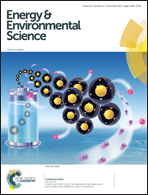Importance of the hydrogen route in up-scaling electrosynthesis for microbial CO2 reduction
Abstract
Microbial electrochemical reduction of CO2 was carried out under two different applied potentials, −0.36 V and −0.66 V vs. SHE, using a biological sludge as the inoculum. Both potentials were thermodynamically appropriate for converting CO2 to acetate but only −0.66 V enabled hydrogen evolution. No acetate production was observed at −0.36 V, while up to 244 ± 20 mg L−1 acetate was produced at −0.66 V vs. SHE. The same microbial inoculum implemented in gas–liquid contactors with H2 and CO2 gas supply led to acetate production of 2500 mg L−1. When a salt marsh sediment was used as the inoculum, no reduction was observed in the electrochemical reactors, while supplying H2 + CO2 gas led to formate and then acetate production. Finally, pure cultures of Sporomusa ovata grown under H2 and CO2 gas feeding showed acetate production of up to 2904 mg L−1, higher than those reported so far in the literature for S. ovata implemented in bioelectrochemical processes. Unexpected ethanol production of up to 1411 mg L−1 was also observed. All these experimental data confirm that hydrogen produced on the cathode by water electrolysis is an essential mediator in the microbial electrochemical reduction of CO2. Implementing homoacetogenic microbial species in purposely designed gas–liquid biocontactors should now be considered as a relevant strategy for developing CO2 conversion.


 Please wait while we load your content...
Please wait while we load your content...